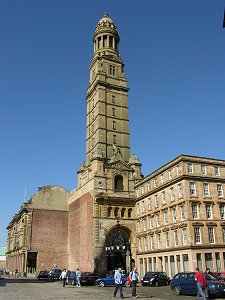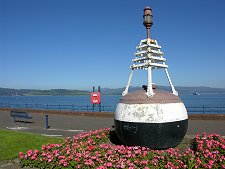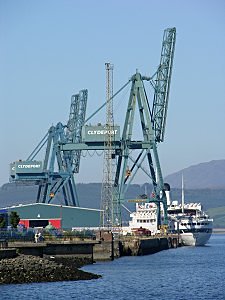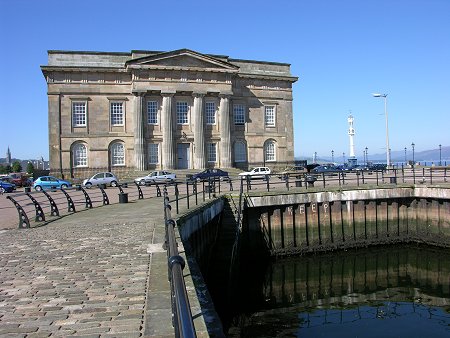 Custom House Quay and the Custom House |
The natural deepwater channel in the River Clyde comes close to its south shore at Greenock, and this helped the town evolve into the major port on Scotland's west coast, servicing almost all of Glasgow's needs until the river upstream from Dumbarton was dredged in the 1800s. It then went on to play its part in Clydeside's role as the shipbuilding capital of the world for the better part of a hundred years. Some 22 miles downstream of Glasgow, most of the town lies on steep north facing slopes giving magnificent views across the Firth of Clyde to the mountains beyond.
In the late 1500s, Greenock was no more than a fishing village in the shadow of a castle that has long since disappeared. In the early 1600s the first pier and breakwater were built at Greenock, and shipbuilding, largely along the foreshore, was already a significant employer in the town.
The first real harbour was built in the years to 1710. The following year the first of the Clyde's well known shipbuilding firms, Scott's was established. It was to produce ships for 277 years until its closure in 1988. The early 1700s saw rapid growth in Greenock, and in 1736 the town's most famous son, James Watt, was born here. Watt's improvements to the steam engines of the day have led many to regard him as one of the most important influences in the coming of the Industrial Revolution.
Watt is far from forgotten in his home town. The James Watt College was founded in 1907 with funds donated by Andrew Carnegie. Its most recent campus was superbly located on the waterfront at Greenock: though the name has been lost since it became part of "West College Scotland". He is also remembered in the name of the James Watt, one of the Wetherspoon chain of pubs housed in a spectacular building on Cathcart Street; and in a statue at the rear of the Town Hall looking across the A8 towards the docks beyond.
Growth continued at a spectacular pace through the 1700s and into the 1800s, largely based on trade with the Americas. The port was developed during this time by John Rennie. By 1850 up to 400 ships each year brought in sugar cane from the Caribbean for processing in Greenock's 14 sugar refineries, which between them supplied half the UK market. And Greenock was a major port of embarkation for emigrants from Scotland to the USA and Canada.
Greenock's growth was hampered by the steepness of its site, and by the absence of a good source of clean water. The second of these was solved in 1827 with the building of a 5 mile long aqueduct which provided an overcrowded population with good drinking water for the first time, and allowed water-powered textile mills to develop in the town.
Greenock was home to many shipbuilders in the late 1800s and further dock improvements were undertaken. Today the only shipbuilder still in operation on this stretch of the Clyde is further upstream at Port Glasgow. But it remains a significant port. The Greenock Ocean Terminal is the main container terminal for the west of Scotland and has daily feeder links to international shipping services via Southampton, Liverpool and Belfast. It is also becoming increasingly popular as a stopping off point for cruise ships.
Greenock itself remains home to many fine buildings. The most spectacular of them is Greenock Municipal Buildings and its 245ft high Victoria Tower. The impressive exterior is matched by an ornate interior. It was completed in 1886. One corner of the Municipal Buildings, next to the base of the tower, comprises just brick faces quite different from the rest of the building. This is Cowan's Corner. It was named after a local shopkeeper, Robert Cowan, who ran a shop on this site and refused to sell up to make room for the Municipal Buildings. As a result they were built with his shop inserted into one corner. The shop was destroyed during a bombing raid in May 1941, leaving the slightly odd effect you see today.
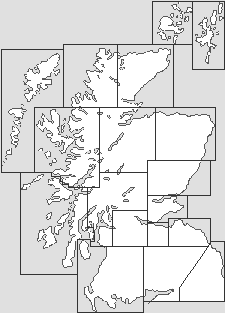
|
|
|
Visitor InformationView Location on MapWhat3Words Location: ///scary.into.proper |
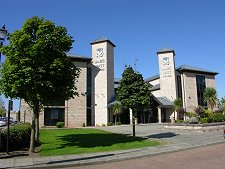 James Watt College |
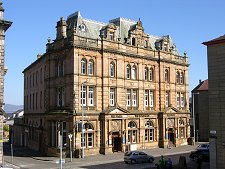 And the James Watt Pub |
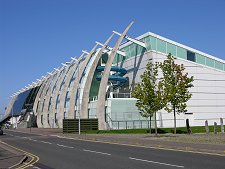 Sports Centre |
